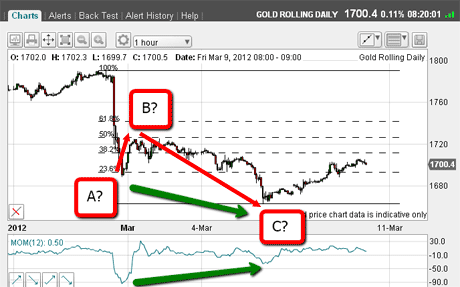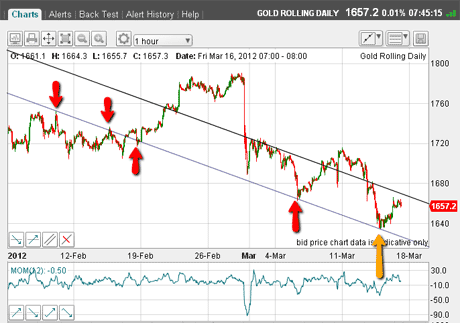Why there could be big trouble ahead for gold
The gold price has fallen when many traders expected it to rise. Does this mark a sea change in sentiment? John C Burford looks to the charts for answers.
One of the most important disciplines for a trader is to keep checking your personal views and assumptions against what the markets are actually doing.
I'm constantly doing this. Nothing is more dangerous than zigging when I should be zagging.
As a matter of fact, trading is not unlike the field of science. As the 19th century naturalist Alexander von Humboldt stated: "A new theory is first derided. Then it is said to be irrelevant. Finally it is accepted, but credited to the wrong person (who has usually stolen it from the originator)".
Subscribe to MoneyWeek
Subscribe to MoneyWeek today and get your first six magazine issues absolutely FREE

Sign up to Money Morning
Don't miss the latest investment and personal finances news, market analysis, plus money-saving tips with our free twice-daily newsletter
Don't miss the latest investment and personal finances news, market analysis, plus money-saving tips with our free twice-daily newsletter
At a major turning point in a market, first the new trend is derided, then it is said to be a just a "technical correction", and then, when it is well underway, it is accepted by the majority just in time for a major reversal!
How markets are driven by human nature
This cycle keeps repeating time after time.
Why? Because its driven by the constant of basic human nature, which explains the connection in these three stages (three being a number that is significant in the Fibonacci sequence, of course).
The part of human nature I'm talking about is the desire to avoid appearing foolish and wrong, especially in public. In the Orient, it is called losing face', and is so powerful it has been responsible for many a suicide. Luckily in the markets, all we lose is money and face.
But as one wag said: "When a person's career and salary depend on believing the improbable, it is very hard to get him to change his mind". And that built-in tendency of institutional rigidity is the reason why Britain sold a major part of its gold reserves in 2002/2003 right at the lows, for example.
As traders, we have the luxury of being unconstrained in our judgments. That's because our success (or otherwise) depends only on us alone being able to outwit the markets, which means we are able to take advantage of the inherent structural weaknesses in the big markets.
So let's get to gold.
In my lastpost about gold on 9 March, I stated that the short-term picture was a little bullish, while the longer-term one was bearish.
The market had made an A-B-C correction to the big move down off the 20 February high at $1,790, and this was the picture then:

(Click on the chart for a larger version)
The large potential positive momentum divergence (green arrow) was a possible launching pad for a more substantial rally. But with the main trend down, something had to give.
In fact, the bears won out and the market moved down to below the C wave, which is what I was looking for. My protective stop just above the B wave high was not in danger, and I retained my short position.
But where to take profits?
This tramline showed me a great place to take profits
It is time to look for possible tramlines. And I have found a beaut:

(Click on the chart for a larger version)
It is the lower line, which touches those pretty touch-points as marked by red arrows. As the market was dropping yesterday towards the yellow arrow, it was fast approaching this line.
That was my cue to take some profit off the table, since the line has represented solid support since 29 February.
That was a very satisfactory gain of well over $100 per oz, or £1,000 on a £1 spread bet.
OK, what now? The market is recovering off the lower tramline towards my not very impressive upper tramline. This may be a turning point for the rally, but I do not have total conviction.
Note from Wednesday'spost on the Dow that in recent days, gold and stocks have diverged. This is counter to the normal relationship that has prevailed for many months.
As I said then, something is amiss and I expect this discrepancy to be eliminated at some point.
Now many traders will be trying to figure out why gold fell hard at a time when stocks were rallying. For what it is worth, my view is that hedge funds who are the largest gold futures traders have become so in love with equities, they sold gold futures to invest the proceeds in stocks.
The implication is that if they were still in love with gold, they would borrow the funds to buy their stocks and keep their gold positions intact.
If I am correct, this is a major shift in sentiment. It spells trouble ahead for both markets.
If you're a new reader, or need a reminder about some of the methods I refer to in my trades, then do have a look at my introductory videos:
The essentials of tramline trading
An introduction to Elliott wave theory
Advanced trading with Elliott waves
Don't miss my next trading insight. To receive all my spread betting blog posts by email, as soon as I've written them, just sign up here .
John is is a British-born lapsed PhD physicist, who previously worked for Nasa on the Mars exploration team. He is a former commodity trading advisor with the US Commodities Futures Trading Commission, and worked in a boutique futures house in California in the 1980s.
He was a partner in one of the first futures newsletter advisory services, based in Washington DC, specialising in pork bellies and currencies. John is primarily a chart-reading trader, having cut his trading teeth in the days before PCs.
As well as his work in the financial world, he has launched, run and sold several 'real' businesses producing 'real' products.
-
 Private school fees soar and VAT threat looms – what does it mean for you?
Private school fees soar and VAT threat looms – what does it mean for you?Rising private school fees could see more than one in five parents pull their children out of their current school. Before you remortgage, move house or look to grandparents for help, here’s what you need to know.
By Katie Williams Published
-
 Best and worst UK banks for online banking revealed
Best and worst UK banks for online banking revealedWhen it comes to keeping your money safe, not all banks are equal. We reveal the best and worst banks for online banking when it comes to protecting your money from scams
By Oojal Dhanjal Published